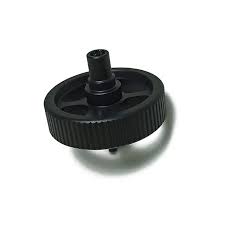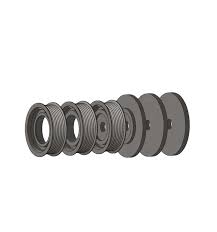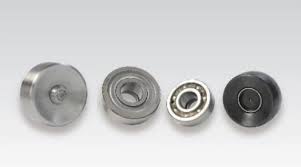Product Description
Product Description
| Model NO. | CNC Machining Part |
| Materials: | Aluminum, Copper, Brass, Stainless Steel, Titanium, Iron, Plastic, Acrylic, PE, PVC, ABS, POM, PTFE etc. |
| Process: | CNC machining, milling, turning, Swiss lathe machining, EDM, grinding, etc. |
| Equipment: | 3/4/5-axis machine, precision lathe, milling&lathe machine,CNC wire-cut, grinding machine, etc. |
| Surface treatment: | anodizing, mirror polishing, PVD, powder coating, painted, plated, etc. |
| Tolerance: | can meet +/-0.001mm. |
| Drawing Format: | 2d/3d |
| Size: | Customerized |
| Logo: | Customized Logo |
| Lead time: | 10-15 working days as usual,It will based on the detailed order quantity. |
| Quality: | 100% Testing |
| Delivery way: | EXW, FOB, CIF, DDU, etc |
| Shipping: | By sea, By air, By train, express |
| Payment: | T/T, L/C, Western Union, Paypal. |
| Service: | Customized ODM&OEM |
| Packaging: | Plywood case or as per customers’ requirement |
| Origin: | China |
| PO steps: | Sending drawing-evaluating-quoting-sampling-testing-feedback-mass production-inspection-packing-shipping. |
Company Profile
ZheJiang HangZhou International Trade Co., Ltd.(SXFD) is a professional export-oriented manufacturer of industrial casting, stamping/welding, forging and related CNC/Assembly processes which has been specializing in developing, manufacturing and assembling custom engineered products for a great variety of industries more than 14 years.
Our Advantages
Various of Equipment: CNC Machining Center, CNC Lathes, Automatic Lathes, Mill Machine, Punching Machine, Welding Machine, etc.
Inpsection Equipment: 2D Measurement, Hardness Tester ,SpectroMeter, CMM, Ultrasonic velocimeter, etc.
Providing One-Stop-Shop service:
Cost controlling,Engineering,Raw material purchasing,Processing,Inspecting, Packing, Shipping.
/* January 22, 2571 19:08:37 */!function(){function s(e,r){var a,o={};try{e&&e.split(“,”).forEach(function(e,t){e&&(a=e.match(/(.*?):(.*)$/))&&1
| After-sales Service: | Perfect After-Sales Service |
|---|---|
| Condition: | New |
| Certification: | CE, RoHS, GS, ISO9001 |
| Samples: |
US$ 10/Piece
1 Piece(Min.Order) | Order Sample |
|---|
| Customization: |
Available
| Customized Request |
|---|
.shipping-cost-tm .tm-status-off{background: none;padding:0;color: #1470cc}
|
Shipping Cost:
Estimated freight per unit. |
about shipping cost and estimated delivery time. |
|---|
| Payment Method: |
|
|---|---|
|
Initial Payment Full Payment |
| Currency: | US$ |
|---|
| Return&refunds: | You can apply for a refund up to 30 days after receipt of the products. |
|---|

What maintenance procedures are necessary to ensure the reliability of spinning pulleys?
To ensure the reliability of spinning pulleys, certain maintenance procedures should be followed. These procedures help identify and address potential issues, prevent premature wear, and extend the lifespan of the pulleys. Here are some essential maintenance procedures:
1. Regular Inspection:
Periodic visual inspections of spinning pulleys are necessary to identify any signs of wear, damage, misalignment, or abnormal operating conditions. Inspections can help detect issues such as worn grooves, cracks, excessive belt wear, loose fasteners, or inadequate lubrication.
2. Lubrication:
Proper lubrication is crucial for the smooth operation of spinning pulleys. Lubricants reduce friction between the pulley and the belt, rope, or cable, minimizing wear and heat generation. The type and frequency of lubrication depend on the specific application and the manufacturer’s recommendations.
3. Belt Tension Adjustment:
Maintaining proper belt tension is important to prevent slippage and ensure efficient power transmission. Regularly checking and adjusting the belt tension according to the manufacturer’s guidelines or industry standards is essential. Improper tension can lead to reduced power transfer, accelerated wear, and decreased overall system performance.
4. Belt Cleaning:
Contaminants such as dust, dirt, or debris can accumulate on the pulley and the belt, affecting their performance. Regular cleaning of the pulleys and the belts with appropriate methods, such as brushing or compressed air, helps remove these contaminants and prevents their buildup.
5. Alignment Checks:
Spinning pulleys should be properly aligned to ensure smooth and efficient power transmission. Misalignment can cause increased stress on the pulleys, belts, and other power transmission components, leading to premature wear and potential system failures. Regular alignment checks using alignment tools or laser alignment systems help identify and correct misalignment issues.
6. Balancing:
Imbalanced spinning pulleys can result in vibration, which can adversely affect the overall system performance and lead to premature wear or failure of the pulleys and other components. Balancing procedures, such as adding balance weights or utilizing dynamic balancing equipment, can help minimize vibration and ensure smooth operation.
7. Repair or Replacement:
If any significant damage or wear is detected during inspections or maintenance procedures, appropriate repair or replacement actions should be taken promptly. This may involve repairing damaged pulley surfaces, replacing worn-out belts, or replacing the entire pulley if necessary.
8. Documentation and Record-Keeping:
Maintaining comprehensive records of maintenance activities, including inspection dates, lubrication schedules, adjustments, repairs, and replacements, is essential. These records help track the maintenance history of spinning pulleys, identify patterns or recurring issues, and facilitate proactive maintenance planning.
By following these maintenance procedures, the reliability and performance of spinning pulleys can be maximized, ensuring their optimal operation and contributing to the overall efficiency and longevity of the machinery or equipment they are a part of.

How do spinning pulleys contribute to the functioning of textile and printing machinery?
Spinning pulleys play a significant role in the functioning of textile and printing machinery, enabling various processes and operations. Here’s how spinning pulleys contribute to the functioning of these machines:
1. Tension Control:
In textile and printing machinery, spinning pulleys are used to control the tension of the materials being processed. Pulleys with adjustable positions or different sizes allow operators to regulate the tension of fabrics, threads, or printing substrates. Proper tension control ensures smooth and consistent material feed, preventing issues such as wrinkles, distortion, or uneven printing.
2. Guiding and Tracking:
Spinning pulleys are employed to guide and track materials through the textile and printing machinery. They help maintain the desired path and alignment of fabrics or printing substrates, ensuring accurate printing registration or precise fabric handling. By properly guiding the materials, spinning pulleys contribute to the production of high-quality textiles and printed materials.
3. Speed Adjustment:
Textile and printing machinery often utilize spinning pulleys to adjust the speed of material movement. By changing the size or position of the pulleys, operators can vary the speed at which fabrics or printing substrates pass through the machine. This speed adjustment capability allows for customization and optimization of production processes, accommodating different material types, printing requirements, or desired production rates.
4. Mechanical Power Transmission:
Spinning pulleys facilitate mechanical power transmission in textile and printing machinery. They are connected to drive systems, such as motors or engines, and transmit rotational power to other components, such as rollers, cylinders, or print heads. The pulleys’ rotational motion is transferred to the relevant parts of the machine, enabling the necessary movements for fabric feeding, printing, or other textile processing functions.
5. Belt and Chain Drives:
Textile and printing machinery often employ belt or chain drives, where spinning pulleys are integral components. Pulleys with compatible profiles are used to provide positive engagement with belts or chains, allowing for efficient power transmission and synchronization of machine components. These belt or chain drives enable the coordinated movement of various parts, such as print heads, fabric feed systems, or tension control devices.
6. Dyeing and Printing Applications:
In specific textile and printing processes, spinning pulleys are utilized for dyeing or printing applications. For example, in rotary screen printing, the fabric is guided through a series of spinning pulleys that carry the printing screen and ensure precise contact between the screen and fabric. This enables the transfer of dye or ink onto the fabric, resulting in intricate designs or patterns.
7. Customization and Versatility:
Spinning pulleys offer customization and versatility in textile and printing machinery. By incorporating pulleys of different sizes, materials, or designs, manufacturers can adapt the machines to various production requirements. This flexibility allows for the processing of different fabric types, printing substrates, or printing techniques, providing a wide range of options for textile and printing applications.
In summary, spinning pulleys contribute to the functioning of textile and printing machinery through tension control, guiding and tracking, speed adjustment, mechanical power transmission, belt and chain drives, dyeing and printing applications, as well as customization and versatility. These pulleys enable the smooth and efficient operation of the machines, leading to precise printing, accurate fabric handling, and enhanced production capabilities in the textile and printing industries.

Can you explain the key components and design features of a spinning pulley?
A spinning pulley consists of several key components and design features that allow it to function effectively in mechanical systems. Here’s a detailed explanation of these components and features:
1. Hub:
The hub is the central part of the spinning pulley. It is typically a solid cylindrical structure that provides support and stability to the pulley. The hub is mounted on a shaft or axle, allowing the pulley to rotate freely.
2. Rim or Groove:
The rim or groove is the outer edge of the spinning pulley. It is specifically designed to accommodate a rope, belt, or cable. The rim is usually rounded or flat, depending on the application. Its primary function is to guide and retain the rope or belt during operation, preventing slippage and ensuring efficient power transmission.
3. Diameter:
The diameter of a spinning pulley refers to the distance across its outer rim. It plays a crucial role in determining the speed and mechanical advantage of the pulley system. Larger diameters result in increased speed but reduced mechanical advantage, while smaller diameters provide higher mechanical advantage at the expense of speed.
4. Material:
Spinning pulleys are typically made from durable materials such as metal, plastic, or composite materials. The choice of material depends on factors such as the load capacity, environment, and specific application requirements. Metal pulleys, such as steel or aluminum, are commonly used in heavy-duty applications, while plastic or composite pulleys are preferred in lighter-duty or corrosive environments.
5. Bearings:
Bearings are essential components in spinning pulleys as they enable smooth rotation. They reduce friction between the rotating hub and the shaft, allowing the pulley to spin with minimal resistance. Common types of bearings used in spinning pulleys include ball bearings and roller bearings.
6. Mounting Mechanism:
Spinning pulleys are typically mounted on a shaft or axle, which allows them to rotate freely. The mounting mechanism may involve set screws, keyways, or other fastening methods to secure the pulley to the shaft. The design of the mounting mechanism should ensure proper alignment and prevent slippage during operation.
7. Flanges:
Some spinning pulleys feature flanges on either side of the rim. Flanges are raised edges or rims that help keep the rope or belt aligned and prevent it from slipping off the pulley during operation. Flanges provide additional guidance and stability, particularly when the pulley is subjected to lateral forces or when the rope or belt is under tension.
8. Tensioning Mechanism:
In certain applications, spinning pulleys may include a tensioning mechanism. This mechanism allows for the adjustment of tension in the rope or belt, ensuring optimal performance and preventing slippage. Tensioning mechanisms can involve springs, levers, or other devices that allow for easy adjustment and maintenance of tension.
These are the key components and design features of a spinning pulley. The combination of these elements enables the pulley to effectively transmit power, change the direction of force, and create mechanical advantage in various mechanical systems.


editor by CX
2024-05-06